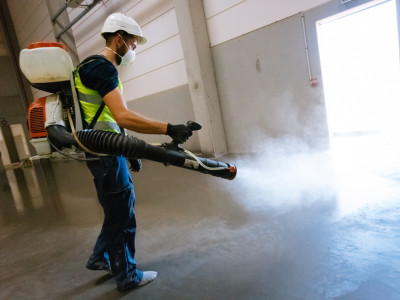Concrete curing agents – what they do, and how to choose the right one
Concrete curing agents are an important part of creating a strong, durable concrete floor. This article explores why they are necessary, and the options for curing and sealing industrial concrete floors.
Why use a concrete curing agent?
When concrete cures, water within the concrete evaporates. If water near the surface of a concrete slab evaporates too quickly, the concrete dries at the surface before drying further down the slab. This causes several problems – most notably:
- a surface that’s prone to cracking and dusting (where the surface scratches away to powder).
- a slab that won’t be able to bear heavy weights as easily, because it has lower strength at the surface.
A concrete curing agent forms a membrane over the top of the concrete slab while it cures. This stops the water near the surface of the slab evaporating too quickly, and hence helps to reduce cracking and dusting.
When a slab has uniform strength, it means it can bear weight and withstand challenging environments more easily – so, curing helps a concrete floor perform to its full potential.
Do concrete curing agents affect efflorescence?
Efflorescence is the presence of a white ‘bloom’ on the surface of the concrete. There are various causes, but water content and temperature are two key factors. It’s particularly noticeable on coloured concrete floors.
Because a concrete curing agent manages the behaviour of water in the slab, it can also play a part in reducing efflorescence.
If efflorescence is of concern, you may also want to consider water-reducing admixtures, as part of your overall concrete mix design.
Should you “cure and seal” a concrete floor?
Curing and sealing are different processes, and are performed for different reasons. Curing we have already explained. Sealing a floor adds protection, so the floor is more durable and easier to clean once the building is in use.
Separate products exist for curing and sealing, often for good reason – existing floors, for example, won’t need a curing agent applied, but can be given a new lease of life by applying a sealant.
However, for a new floor, there are benefits to both processes. Using the same product for curing and sealing ensures that the two will be compatible, preventing any unwelcome chemical reactions between the two.
Can you use curing agents on coloured concrete floors?
Although in some instances curing agents can be used with coloured concrete floors and surface hardeners, it is always wise to check specification sheets and to test. For example, our Roc Cure and Roc Seal products can be used on a floor where a surface hardener is used. However, Roc Seal Premium should only be used on coloured concrete after 28 days.
There are many anecdotes of contractors who have not followed manufacturers’ instructions and have been left with unhappy clients and costly remedial work – so it pays to test and take care.
It’s important to remember that the curing agent is just one part of the whole concrete floor specification. Also important are the amount of water in the mix, and the amount of bleed water (so that a surface hardener can be well applied without risk of delamination). We are always happy to advise.
Concrete curing agents – what are the options?
There are two types of concrete curing agents – water based and solvent based. In terms of performance, these are similar. The differences occur during application.
- Water based – this goes on as a white liquid which dries clear. It works over 7 days and penetrates the surface to prevent crazing. Water-based curing agents are ideal for projects where there is a fast turnaround time – eg, our Ecocure 17 is surface dry after one hour at 20⁰C, and usable after eight hours. It is also suitable for use on self-compacting concrete floors. Being water-based, there are minimal handling concerns, as the product is non-flammable and non-toxic.
- Solvent based – this is sprayed on as a as a clear liquid, and works over a longer time period – 28 days. Because it is solvent based, it is flammable, and should be handled and applied with care. Take a look at our Roc Cure product.
These are our two concrete curing agents, but we also offer combined curing and sealing products – Roc Seal and Roc Seal Premium. Please browse our product section for details.




